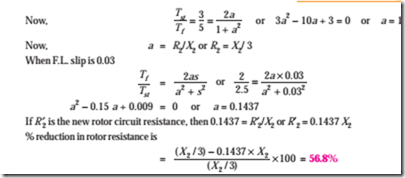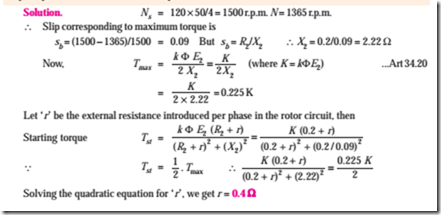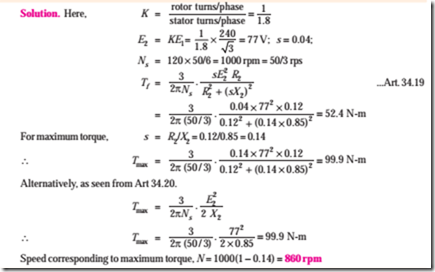Starting Torque and Maximum Torque
Thus a reduction of 10% in line voltage causes about 23% increase in Cu losses.
Example. 34.13 (b). A 230-V, 6-pole, 3-f, 50-Hz, 15-kW induction motor drives a constant torque load at rated frequency, rated voltage and rated kW output and has a speed of 980 rpm and an efficiency of 93%. Calculate (i) the new operating speed if there is a 10% drop in voltage and 5% drop in frequency and (ii) the new output power. Assume all losses to remain constant.
Example 34.14 (a). A 3-phase, 400/200-V, Y-Y connected wound-rotor induction motor has 0.06W rotor resistance and 0.3 W standstill reactance per phase. Find the additional resistance required in the rotor circuit to make the starting torque equal to the maximum torque of the motor.
(Electrical Technology, Bombay Univ. 1990)
Example 34.14 (b). 3-phase, 50-Hz, 8-pole, induction motor has full-load slip of 2%. The rotor- resistance and stand still rotor-reactance per phase are 0.001 ohm and 0.005 ohm respectively. Find the ratio of the maximum to full-load torque and the speed at which the maximum torque occurs.
(Amravati University, 1999)
Example 34.14 (c). A 12-pole, 3-phase, 600-V, 50-Hz, star-connected, induction motor has rotor-resistance and stand-still reactance of 0.03 and 0.5 ohm per phase respectively. Calculate:
(a) Speed of maximum torque. (b) ratio of full-load torque to maximum torque, if the full-load speed is 495 rpm.
(Nagpur University, April 1999)
Example 34.15. A 746-kW, 3-phase, 50-Hz, 16-pole induction motor has a rotor impedance of (0.02 + j 0.15) W at standstill. Full-load torque is obtained at 360 rpm. Calculate (i) the ratio of maximum to full-load torque (ii) the speed of maximum torque and (iii) the rotor resistance to be added to get maximum starting torque.
(Elect. Machines, Nagpur Univ. 1993)
Example 34.16. The rotor resistance and reactance per phase of a 4-pole, 50-Hz, 3-phase induction motor are 0.025 ohm and 0.12 ohm respectively. Make simplifying assumptions, state them and :
(i) find speed at maximum torque
(ii) find value of additional rotor resistance per phase required to give three-fourth of maximum torque at starting. Draw the equivalent circuit of a single-phase induction motor.
(Elect. Machines, Nagpur Univ. 1993)
Solution. (i) At maximum torque, s = R2/X2 = 0.025/0.12 = 0.208.
Example. 34.17. A 50-Hz, 8-pole induction motor has F.L. slip of 4%. The rotor resistance/phase = 0.01 ohm and standstill reactance/phase = 0.1 ohm. Find the ratio of maximum to full-load torque and the speed at which the maximum torque occurs.
Example 34.18. For a 3-phase slip-ring induction motor, the maximum torque is 2.5 times the full-load torque and the starting torque is 1.5 times the full-load torque. Determine the percentage reduction in rotor circuit resistance to get a full-load slip of 3%. Neglect stator impedance.
(Elect. Machines, A.M.I.E. Sec. B, 1992)
Example 34.19. An 8-pole, 50-Hz, 3-phase slip-ring induction motor has effective rotor resistance of 0.08 W/phase. Stalling speed is 650 r.p.m. How much resistance must be inserted in the rotor phase to obtain the maximum torque at starting? Ignore the magnetising current and stator leakage impedance.
(Elect. Machines-I, Punjab Univ. 1991)
Solution. It should be noted that stalling speed corresponds to maximum torque (also called stalling torque) and to maximum slip under running conditions.
Example 34.21. A 4-pole, 50-Hz, 7.46.kW motor has, at rated voltage and frequency, a starting torque of 160 per cent and a maximum torque of 200 per cent of full-load torque. Determine (i) full- load speed (ii) speed at maximum torque.
(Electrical Technology-I, Osmania Univ. 1990)
Example 34.22. A 3-phase induction motor having a 6-pole, star-connected stator winding runs on 240-V, 50-Hz supply. The rotor resistance and standstill reactance are 0.12 ohm and 0.85 ohm per phase. The ratio of stator to rotor turns is 1.8. Full load slip is 4%.
Calculate the developed torque at full load, maximum torque and speed at maximum torque.
(Elect. Machines, Nagpur Univ. 1993)
Example 34.23. The rotor resistance and standstill reactance of a 3-phase induction motor are respectively 0.015 W and 0.09 W per phase. At normal voltage, the full-load slip is 3%. Estimate the percentage reduction in stator voltage to develop full-load torque at half full-load speed. Also, calculate the power factor.
(Adv. Elect. Machines, A.M.I.E. 1989)
Solution. Let Ns = 100 r.p.m. F.L. speed = (1 – 0.03)100 = 97 r.p.m.













